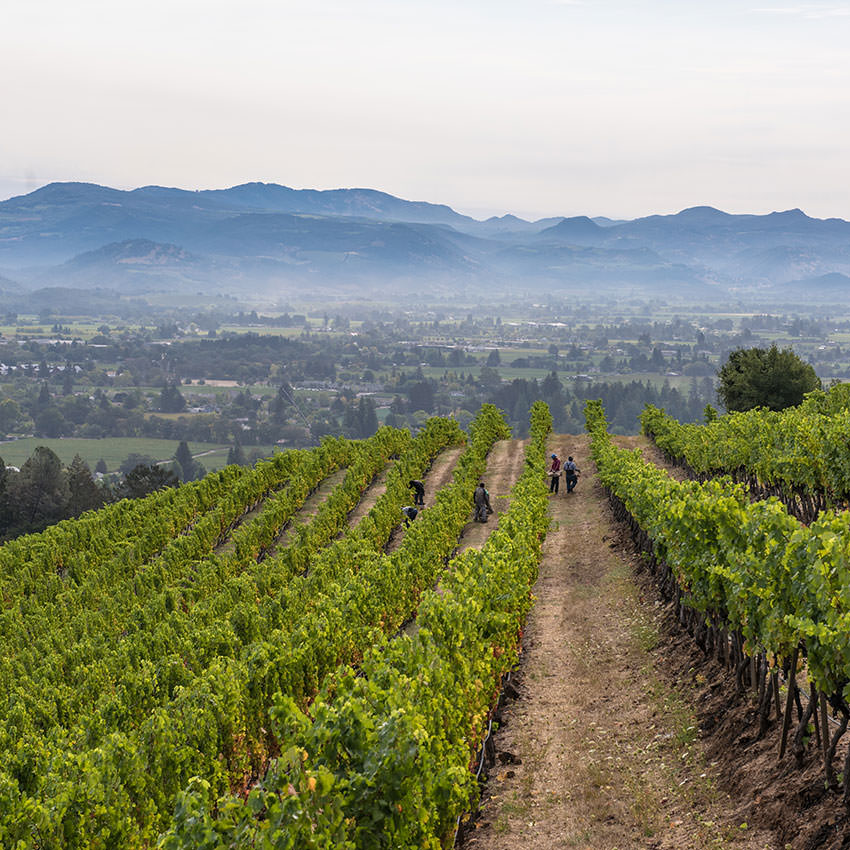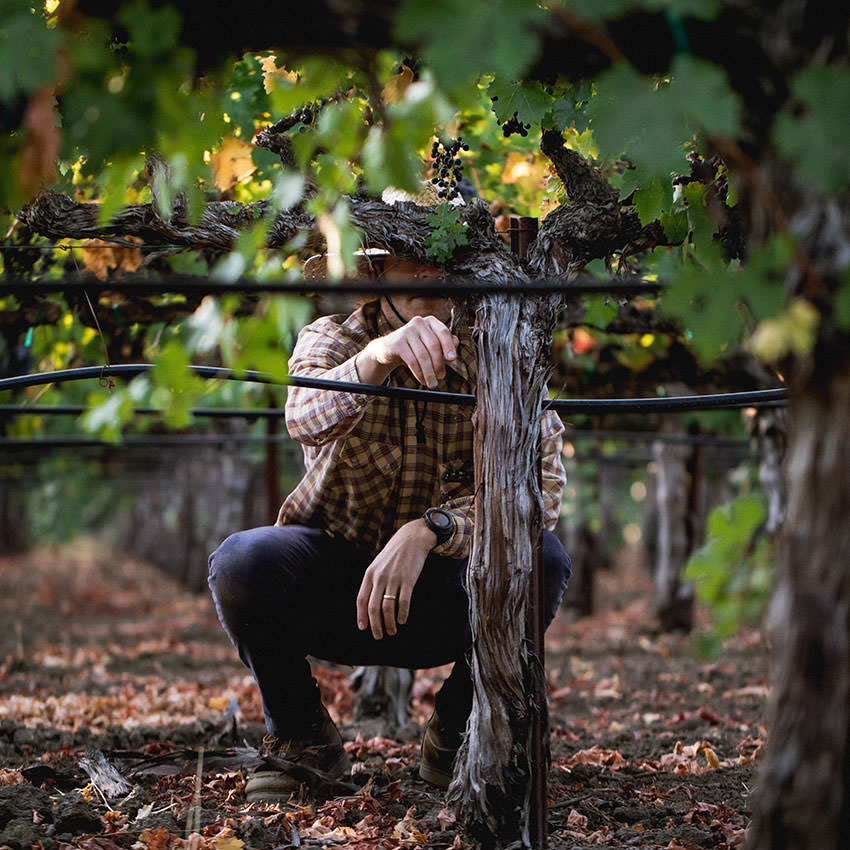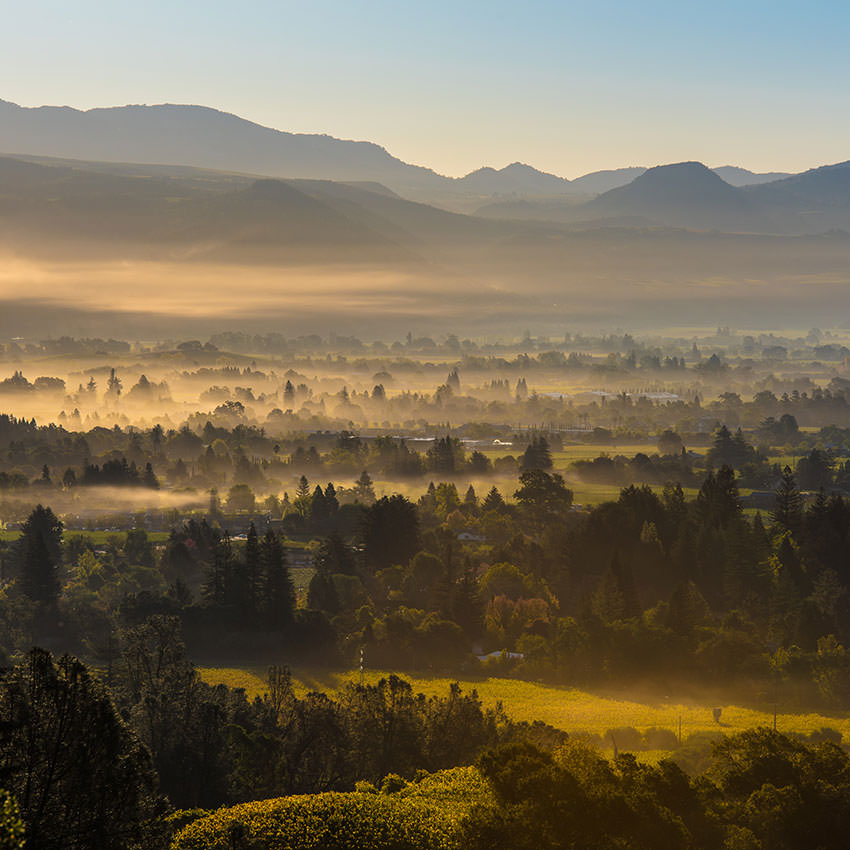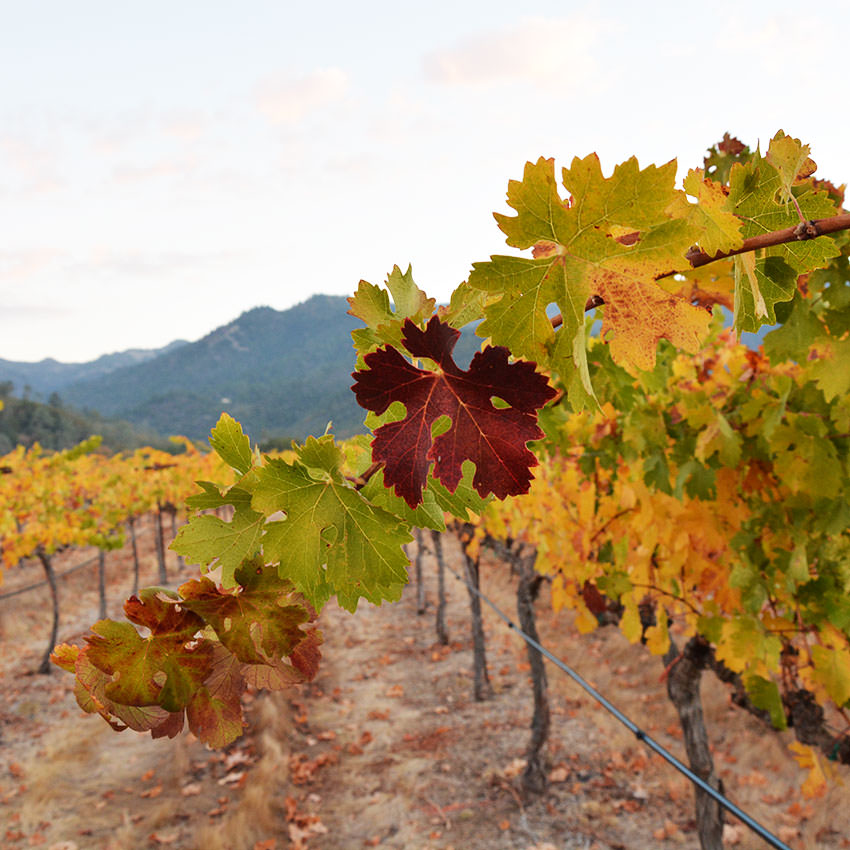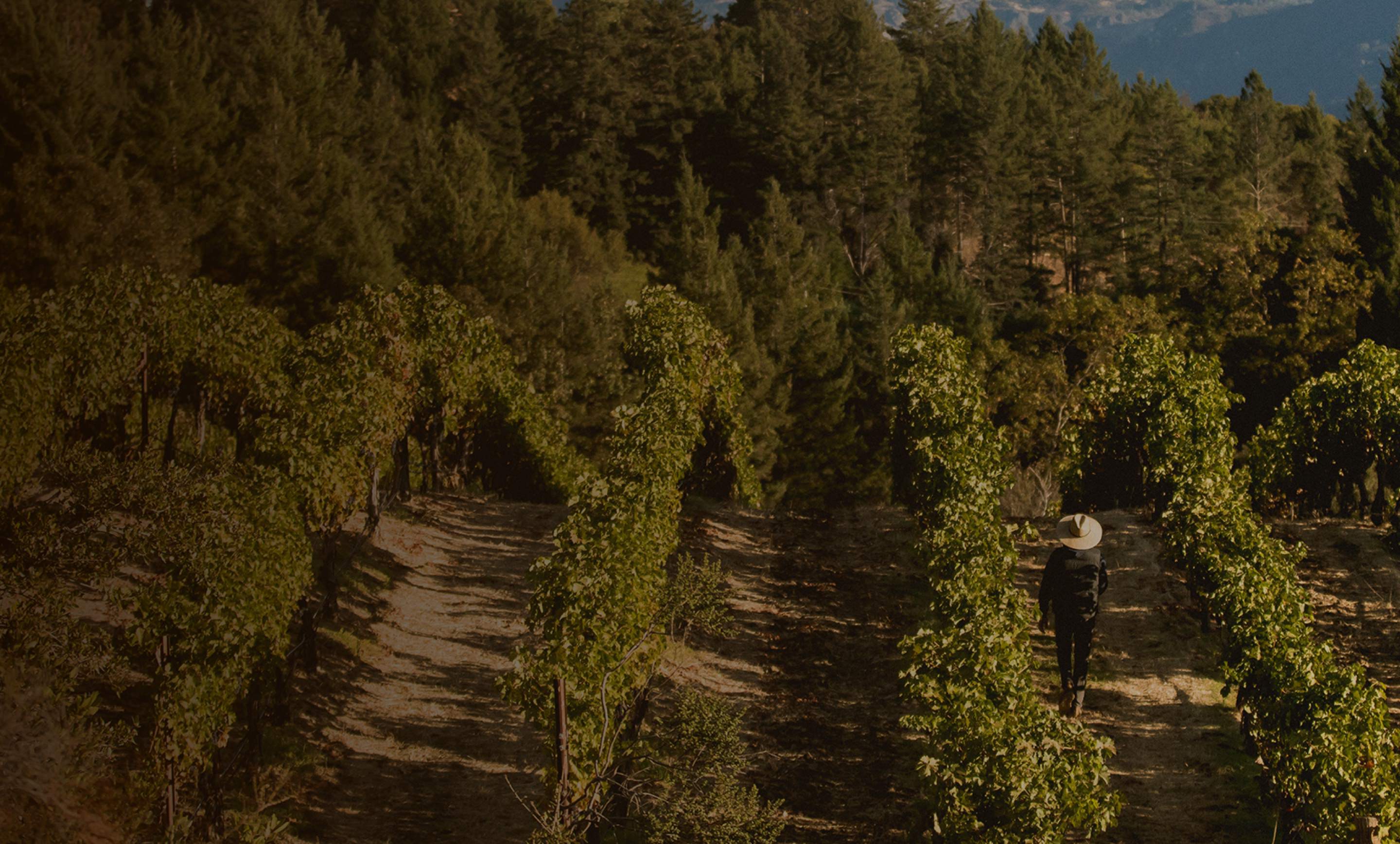
The Region
Suited to Produce Extraordinary Wine
Timeline
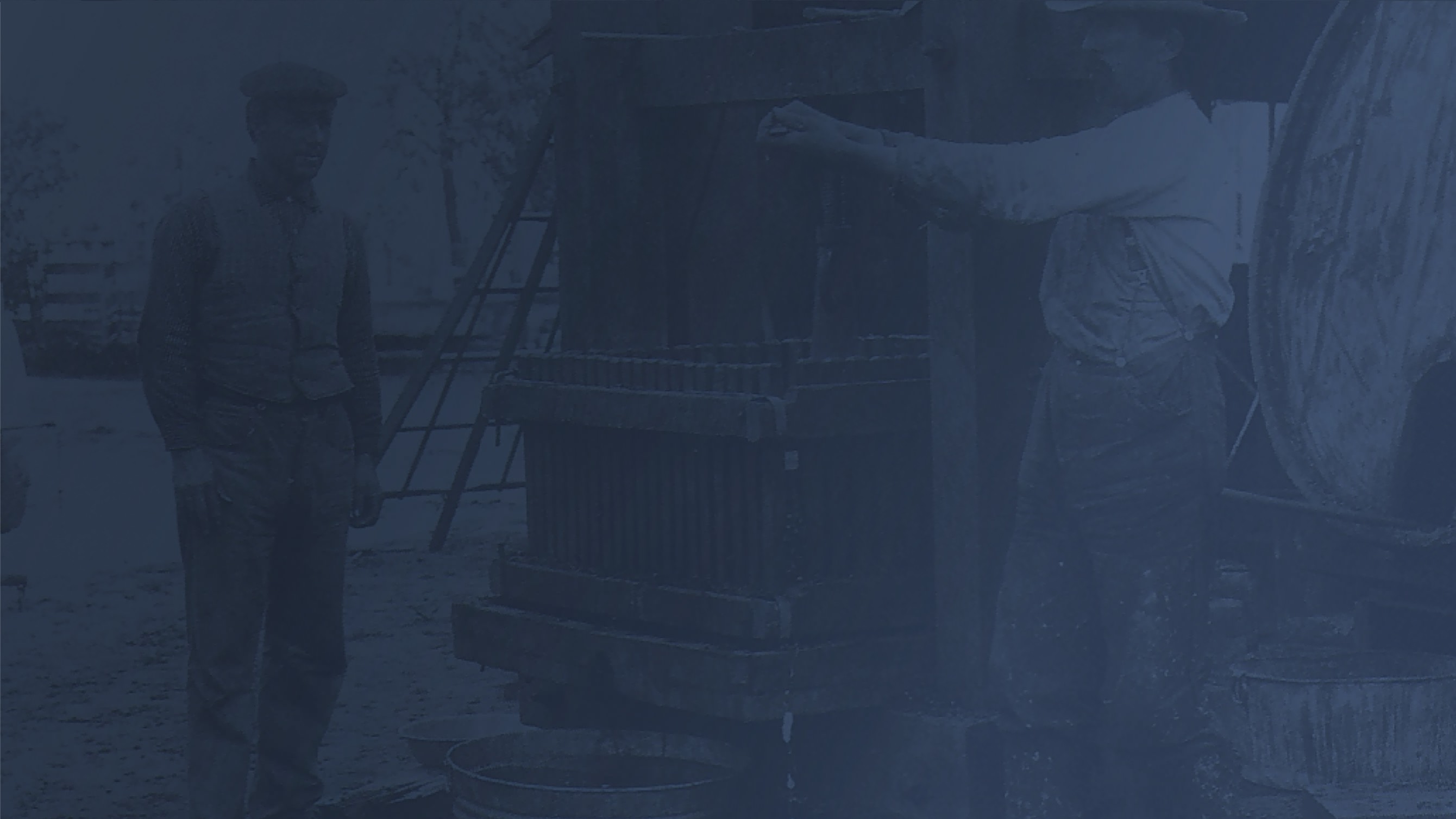
New World Wine Region Created
Our Beginnings
European immigrants begin to settle a lush California valley, making wines to rival their homelands.
While the Napa Valley was home to cultivated grapevines as early as 1653 with the planting of Mission grapes by Spanish missionaries, the Napa Valley wine industry as we know it today got its start in 1836.
In the early 1800s, much of the United States’ wine production came from New York, Virginia, Ohio and Missouri. After being awarded a Mexican Land Grant in what was at the time still northern Mexico, a young trapper by the name of George Calvert Yount first planted commercial grapevines in the Napa Valley. The city of Yountville would eventually be named in his honor.
Soon thereafter, a wide variety of immigrants, pioneers, visionaries and risk takers followed suit, each contributing to the colorful history of the Napa Valley in their own way. With a drive to make wine to rival their homelands, and an ingenuity unhindered by the Old World decrees of winemaking, they forged a path forward in this New World of wine.
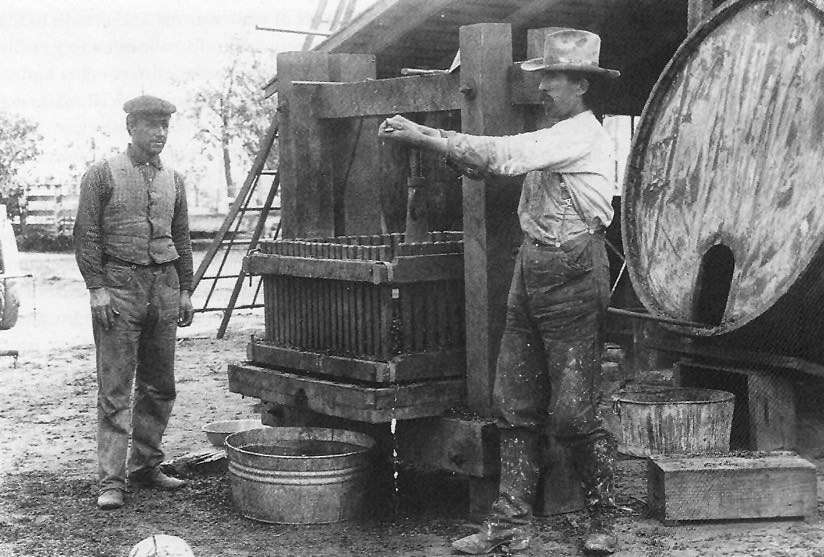
1836

One Region’s Bust is Another’s Boom
The Gold Rush & Napa’s First Wave
California’s Gold Rush leaves most high and dry, and many look to a new economic opportunity in the nearby Napa Valley.
As the booming industry of the California Gold Rush began to reveal itself as a bust, many settlers of San Francisco—including merchants, farmers, prospectors, and wealthy speculators—began to make their way out of the big city into the surrounding countryside.
Napa County was a popular destination for many farmers, and it was in the 1850s that Joseph Osborne planted vines on a parcel of land that he would come to call Oak Knoll. In 1859, Samuel Brannan planted vines on Agua Caliente Ranch, and named the surrounding region Calistoga.
Armed with a cider press and a visionary’s mindset, John Patchett is credited for opening the first commercial winery in the Napa Valley in 1859, hiring Charles Krug as his winemaker and earning the Napa Valley’s first wine review from California Farmer Magazine: “The white wine was light, clear and brilliant and very superior indeed; his red wine was excellent; we saw superior brandy, too.”
California Farmer Magazine would soon thereafter publish the first paper highlighting the potential profits of planting European grape varieties and making wine in the Napa Valley.
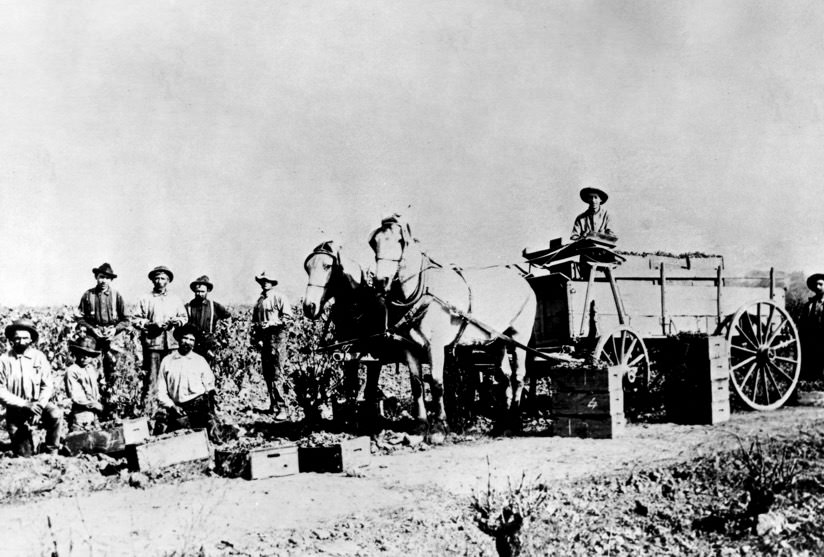
1850
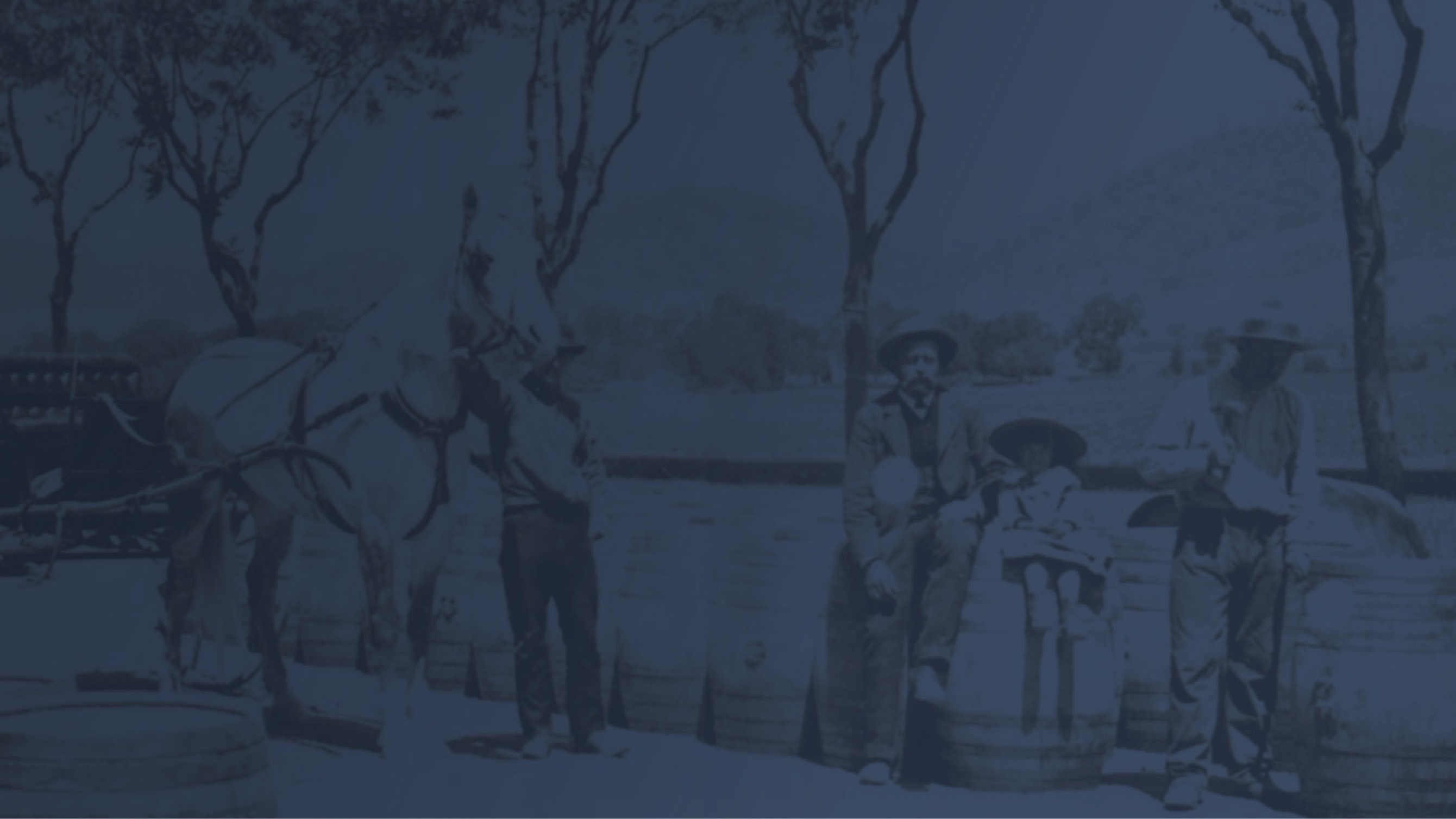
An Era of Excitement and Abundance
Roots in Napa Valley
The Napa Valley as we know it is founded by some very recognizable names and truly begins to flourish.
In the late 19th century, many of today’s household names established their roots in the Napa Valley.
In 1862, Jacob Schram founded Schramsberg after emigrating from Germany. In 1864, Thomas Rutherford married Elizabeth Yount and received a wedding gift of a thousand acres of vineyards from her grandfather, George Yount. In 1868, a farmer named Hamilton Walker Crabb purchased a parcel of land from George Yount’s son-in-law that would eventually become the famed To Kalon Vineyard. Beringer Winery was founded by brothers Jacob and Frederick Beringer in 1875, who had cut their teeth in the wine industry working for Charles Krug.
In addition to planting vineyards, there was a veritable industry being built in the Napa Valley around the wine itself. It was in the 1860s that Charles Kohler founded both Pacific Glass Works to produce wine bottles and Kohler & Frohling to export California wine. In 1872, Uncle Sam Wine Cellars opened its considerably large doors, touting the capacity to make up to 2 million bottles of wine.
In stark contrast to the lack of gold available in San Francisco, there was an abundance of success to be had in the wine industry of the Napa Valley. In the span of just two decades, the number of acres of vineyards skyrocketed, growing more than 100 times from 225 acres in 1856 to 24,664 acres in 1875. And by the end of the 19th century, there would be nearly 200 wineries in the Napa Valley.
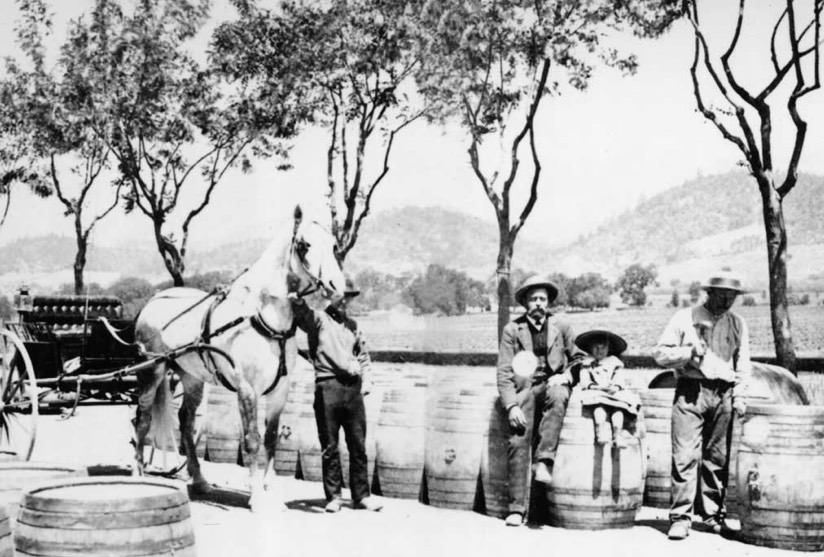
1860s
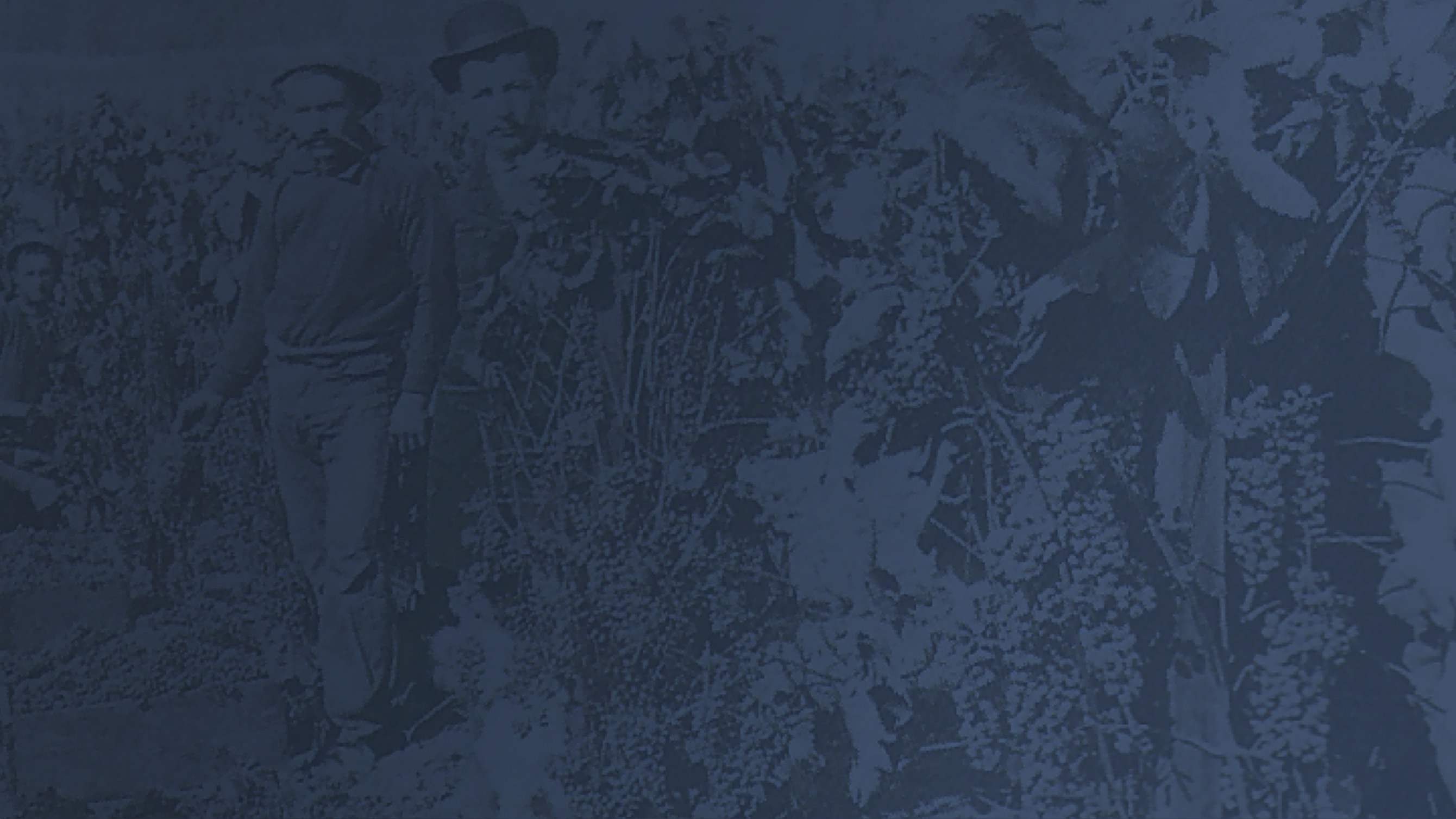
Experience & Expertise Lead the Way
The Quality Revolution
Vintners band together and begin to set the winemaking standards that the Napa Valley is known for today.
While the Napa Valley was quickly expanding its acres planted and total wineries, it was also establishing its winemaking process and garnering its reputation as a powerful winemaking force of the New World.
In 1875, winemaking pioneers Charles Krug, Henry Pellet and Seneca Ewer founded the St. Helena Viticultural Society, establishing a unity among vintners who were facing similar challenges. Their first focus was to improve the quality of the wines being made in the Napa Valley, and they aimed to popularize the planting of European grape varieties over Mission grapes. Soon the vineyards of the time were planted to a myriad of French, German and Italian varieties, the most popular being Zinfandel and Petite Sirah. During this same era, vintners began to recognize the particular potential of Bordeaux-style wines in the Napa Valley. In 1876, Morris Estee founded Hedgeside Vineyards, which would go on to become the very first to plant Cabernet Sauvignon in the Napa Valley. Inglenook was founded in 1879 by Gustave Niebaum, who made it his mission to improve the Napa Valley’s wine reputation. Inglenook would eventually be honored for producing the first truly Bordeaux-style wines in the Napa Valley.
In 1880, the first wine research center of the New World was founded at the University of California by Dr. Eugene Hilgard. A soil scientist, he began studying grapes that were best suited for the climate, soil and terroir of California. This program would eventually become the Agricultural Extension Program at the University of California, Davis.
Vintners were beginning to understand exactly how certain grapes grew in the varied soil of the Napa Valley, seeking out parcels of land specifically for its grape-growing qualities, and furthering the prestige of the land from the steep hillsides to the valley floor.

1870s

A Rising Star in the World of Wine
The First Boom
The Napa Valley’s unique terroir, climate and spirit of American entrepreneurship draw many talented vintners to the area.
By the turn of the 20th century, the news had spread about the Napa Valley’s near-perfect combination of a warm climate, great soil and available land. And news was beginning to spread around the world about the quality of wine coming from this small valley in California.
With the total number of acres planted on the rise, so were the number of wineries popping up in the Napa Valley. By 1890, there were nearly 200 wineries in Napa and the surrounding valley, and 11 million cases of wine were produced in the state annually, most of it coming from the Napa Valley.
There were many wineries who were raising the quality bar even higher, and the world began to take notice. In 1889, both Inglenook and Migliavacca Wine Company won gold medals at the Paris World’s Fair (nearly a century prior to the famed Judgement of Paris of 1976).
There was a sea change occurring in the Napa Valley in the late 19th century that made the area an exciting place to be in the world of wine. In 1881, Josephine Tychon became the first female vintner of the Napa Valley. The Napa Valley wine industry was a rising star, but their star would soon fall in the face of multiple hardships, from which Napa took decades to recover.

1890s
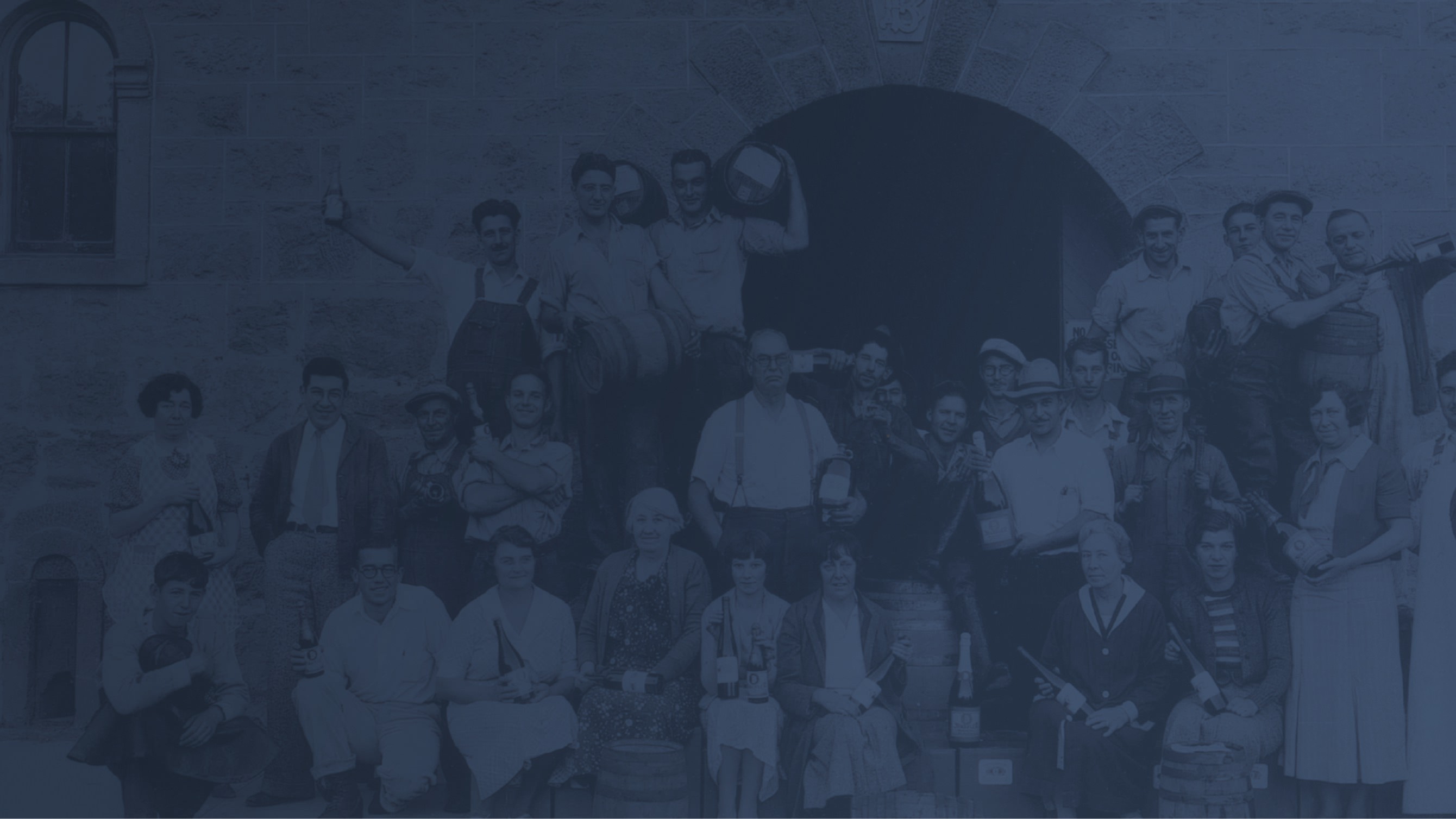
Phylloxera, Prohibition and the Depression
Weathering Storms
After an exciting boom, hard times hit the Napa Valley at the turn of the 20th century.
As the wine industry boom was reaching its peak, a very small insect was also settling in the Napa Valley, feeding off the copious grapevines it needed to flourish. And the United States was about to hit its own dry spell.
This insect, Phylloxera, is a root louse that feeds off the roots and leaves of a vine, and was so prolific in the Napa Valley that it quickly decimated over 80% of the total vines planted. The Phylloxera outbreak was so hard-hitting that many of the Napa Valley’s vintners turned to ripping out their vines and planting other crops, such as walnuts and prunes.
The solution was eventually found in using Phylloxera-resistant rootstock of a native Northern Californian vine, but the few wineries who were able to withstand the outbreak were soon hit with another hardship. In 1918, the Volstead Act was passed and Prohibition went into effect in the United States in 1920. This decimated the wine industry even further. A very select few were able to remain open by producing sacramental wine or selling barrels of grape juice (perhaps along with instructions on exactly how not to ferment it at home). But most were forced to let their vines die off or abandon their land altogether.
The Great Depression would soon hit the entire country, causing most industries to struggle, and the Napa wine industry was certainly no exception. Only a very few wineries are open today who managed to weather the storms of the early 20th century.

1920s
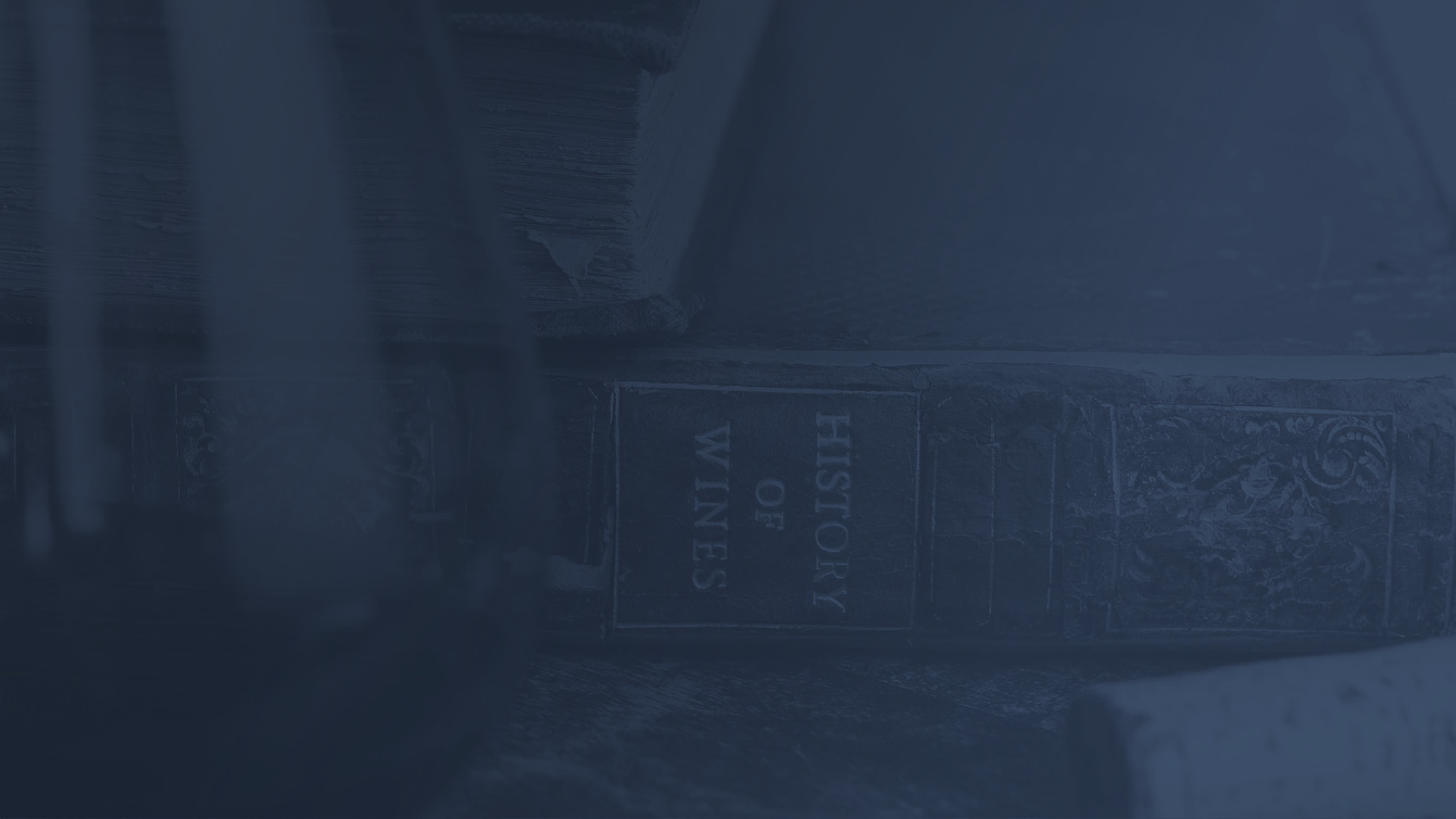
A New Generation of Pioneers
Recovery & Rebuilding
As the grandfathers of today’s Napa Valley rebuild the wine industry, Cabernet Sauvignon emerges as the valley’s muse.
The next generation of pioneers reinvented the wine business of the Napa Valley: Georges de Latour, André Tchelistcheff, John Daniels, Martin Stelling and Robert Mondavi began to rebuild the Napa Valley.
Georges de Latour is credited with ridding the Napa Valley of the Phylloxera outbreak by introducing rootstock resistant to the bug, which paved the way for new winemakers to come to the region and rebuild the wine industry after Prohibition and the Great Depression. He also hired André Tchelistcheff as his winemaker at Beaulieu Vineyards in 1938. Tchelistcheff, who emigrated from France for the job, is responsible for introducing many modern winemaking techniques to the Napa Valley, including: the replanting of French varieties; frost protection, using small, French oak barrels for aging; malolactic fermentation; eliminating pasteurization; and using cold fermentation to maintain flavor and color.
Along with Tchelistcheff, Martin Sterling and Caesar Mondavi were among the first to identify Bordeaux varieties, particularly Cabernet Sauvignon, as ideally suited for the Napa Valley. Louis M. Martini and Inglenook wineries were some of the first to bottle the single variety Cabernet Sauvignon for which the Napa Valley would become world-renowned.
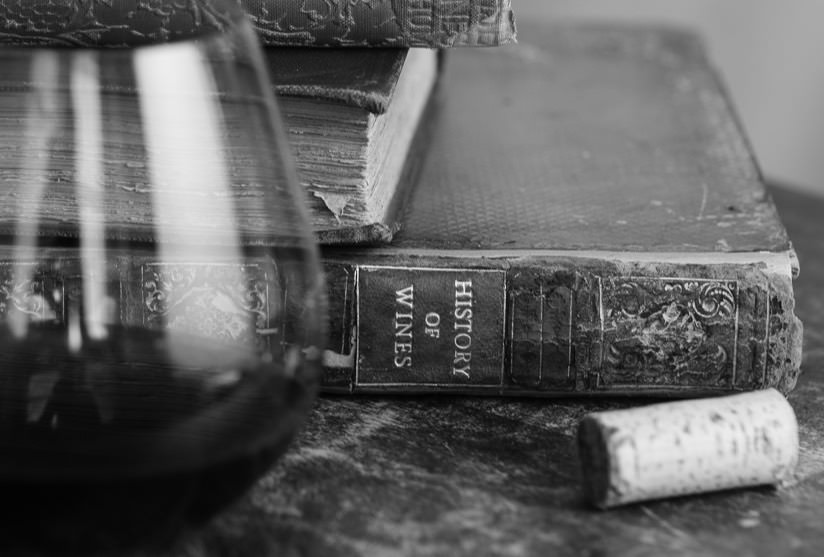
1940s
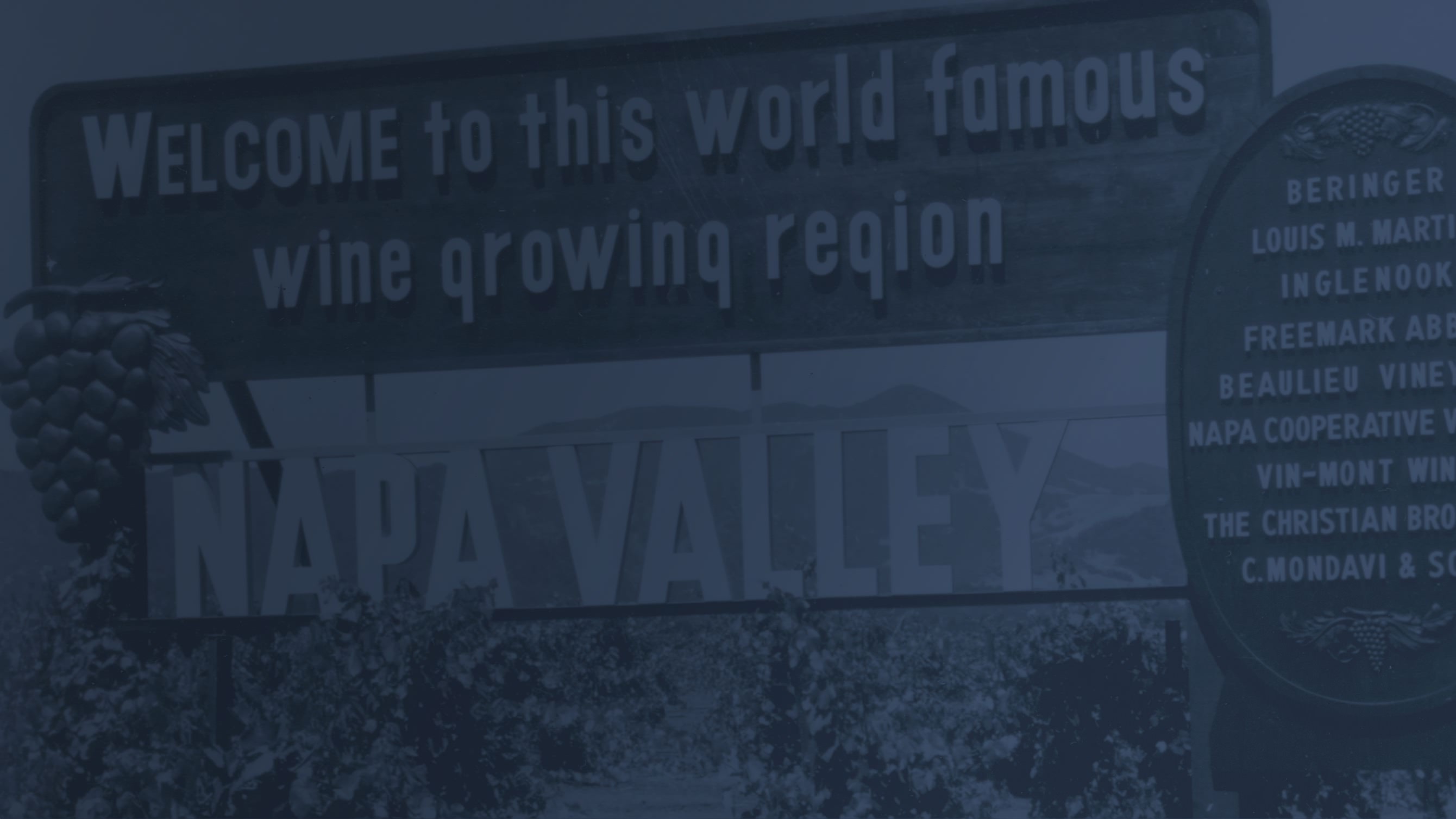
Working Better Together
Napa Valley Vintners Founded
This group lays the groundwork for the Napa Valley to become one of the premier winegrowing regions of the world.
The Napa Valley Vintners was founded by seven vintners with the vision to work together to make the industry stronger, a thread that unites the Napa Valley across centuries.
In the early 1940s, the quickly expanding Napa Valley wine industry faced a number of problems, including price controls and a daunting shortage of labor, bottles and rail cars in order to ship wine across the country.
In 1943, Louis M. Martini, John Daniel Jr., Charles Forni and Louis Stralla discussed forming an association, a vintners’ forum, that would allow a regular opportunity to exchange ideas. Their vision was to work as a group to overcome some of these obstacles and elevate the status of Napa Valley wines. This team of vintners believed they could solve industry-related problems better collectively than as individuals.
By 1944, an agreement was drafted and signed by seven vintners: Fernande de Latour of Beaulieu Vineyard, Felix Salmina of Larkmead, Charles Forni of the Napa Valley Co-op, Robert Mondavi of CK Mondavi and Sons, John Daniel Jr. of Inglenook, Louis M. Martini and Louis Stralla.
Although the original members of the Napa Valley Vintners often referred to themselves as “an eating and drinking society,” they set in motion the hospitality, industry advocacy and marketing activities that have focused worldwide attention on the uniqueness of this small valley as one of the premier winegrowing regions in the world.

1944

The Highest and Best Use of the Land
The Napa Valley is the Country's First Agricultural Preserve
In a visionary act, the vintners of the Napa Valley place permanent protection on the land and prevent future overdevelopment of the region.
In the first of its kind in the US, the Napa Valley becomes a protected Agricultural Preserve, identifying agricultural and open space as the highest and best use of the land.
In April 1968, after hearing the outcry of the vintners and residents of the Napa Valley, the US government enacted the country’s first Agricultural Preserve, with a goal to preserve open space and prevent future over-development.
This visionary land-zoning ordinance established agriculture and open space as the best use for the land in the fertile valley and foothill areas of Napa County. Initially, the ordinance protected 23,000 acres of agricultural land stretching from Napa to Calistoga. Today, more than 32,000 acres are contained within the Preserve, and no land has ever been removed.
Vintners have played a pivotal role in the history of Napa Valley’s preservation and will continue to play a vital role in ensuring that the pastoral beauty and intact natural environment that we all enjoy today still exists for future generations.
“We either fight really hard to keep what we have in terms of agriculture, or we’re absorbed into the Bay Area metropolitan region.” – David Morrison, County Planning, Building and Environmental Services Director
Today, the Ag Preserve enjoys widespread local support and continues to be the cornerstone of preserving and elevating Napa County’s agricultural heritage.
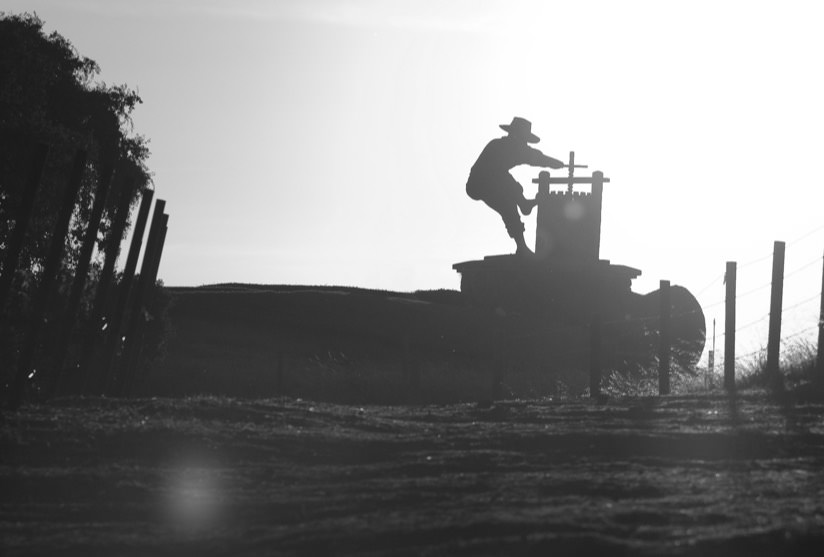
1968
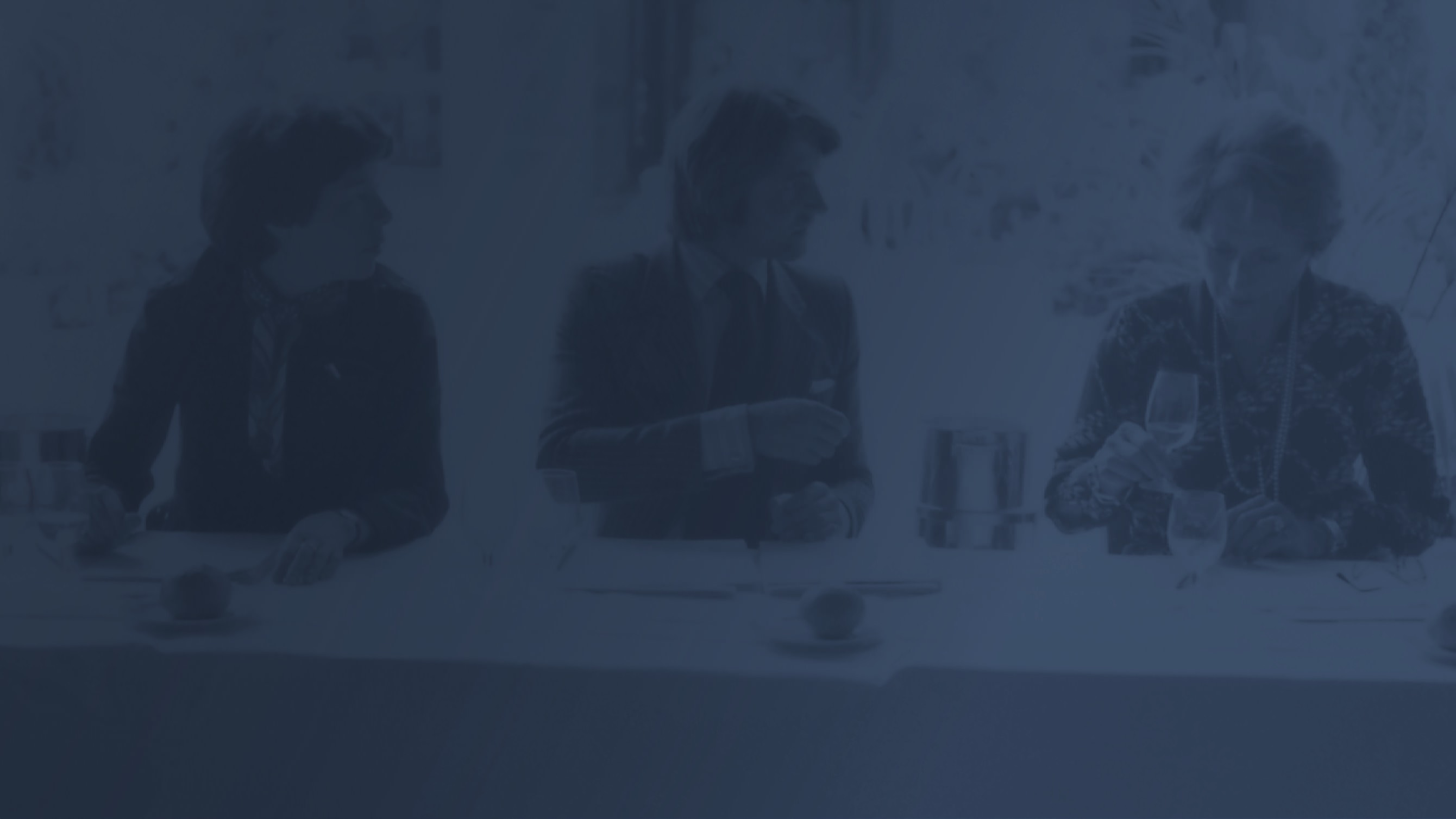
A Turning Point for the Napa Valley
The Judgement of Paris
In a landmark blind tasting, Napa Valley Chardonnay and Cabernet Sauvignon take top honors against French wines.
Six Napa Valley Cabernet Sauvignons and six Chardonnays were blind tasted against four French Bordeaux and four Burgundies in a pivotal moment for Napa Valley wine.
The brainchild of a British wine merchant who exclusively imported French wines over California wines, the Judgement of Paris was universally expected to prove the superiority of French wines. This was the generally accepted idea of the time, after all. Eleven judges, nine of them French, gathered to blind taste all 20 wines on May 24, 1976. The results surprised the world—with perhaps the exception of anyone living in the Napa Valley.
The 1973 Chateau Montelena Chardonnay and the 1973 Stag’s Leap Cabernet Sauvignon took the top honors, both from the Napa Valley. The event was notoriously unattended by the press, with the exception of a single reporter from TIME Magazine, who reported the story and immediately provided the credibility and recognition that Napa had so long been earning. This definitively launched the modern era for the Napa Valley wine industry, and secured its position as the epicenter of New World wine.

1976

Appreciation of Terroir
The Napa Valley AVA Is Established
With vineyard-designate wines gaining in popularity, the state’s first American Viticultural Area (AVA) is created in the Napa Valley.
With international acclaim for the region, Napa vintners and residents pushed to establish the state’s first American Viticultural Area (AVA).
In the 1970’s, the concept of single-vineyard wines was popularized in the Napa Valley by pioneers such as Joseph Heitz, Diamond Creek and Milton Eisele. These winemakers and growers believed that making vineyard-designate wines was the only way to show the distinct properties of the land. In 1971, Eisele began to insist that any winery purchasing fruit from his Eisele Vineyard should include his vineyard’s name on the label.
This newfound focus on the unique terroir of the Napa Valley led to a proposal to establish the Napa Valley as a defined American Viticultural Area. Once the proposal was posted, the Bureau of Alcohol, Tobacco and Firearms (ATF) received over 100 written comments from residents and vintners alike pushing for the creation of this new Napa Valley AVA.
Thus, the AVA was quickly defined and passed on January 28, 1981. In the subsequent years, the Napa Valley AVA became home to 16 individual sub- or “nested” AVAs, further proving the unique characteristics of the varied terroir in this small valley.

1981
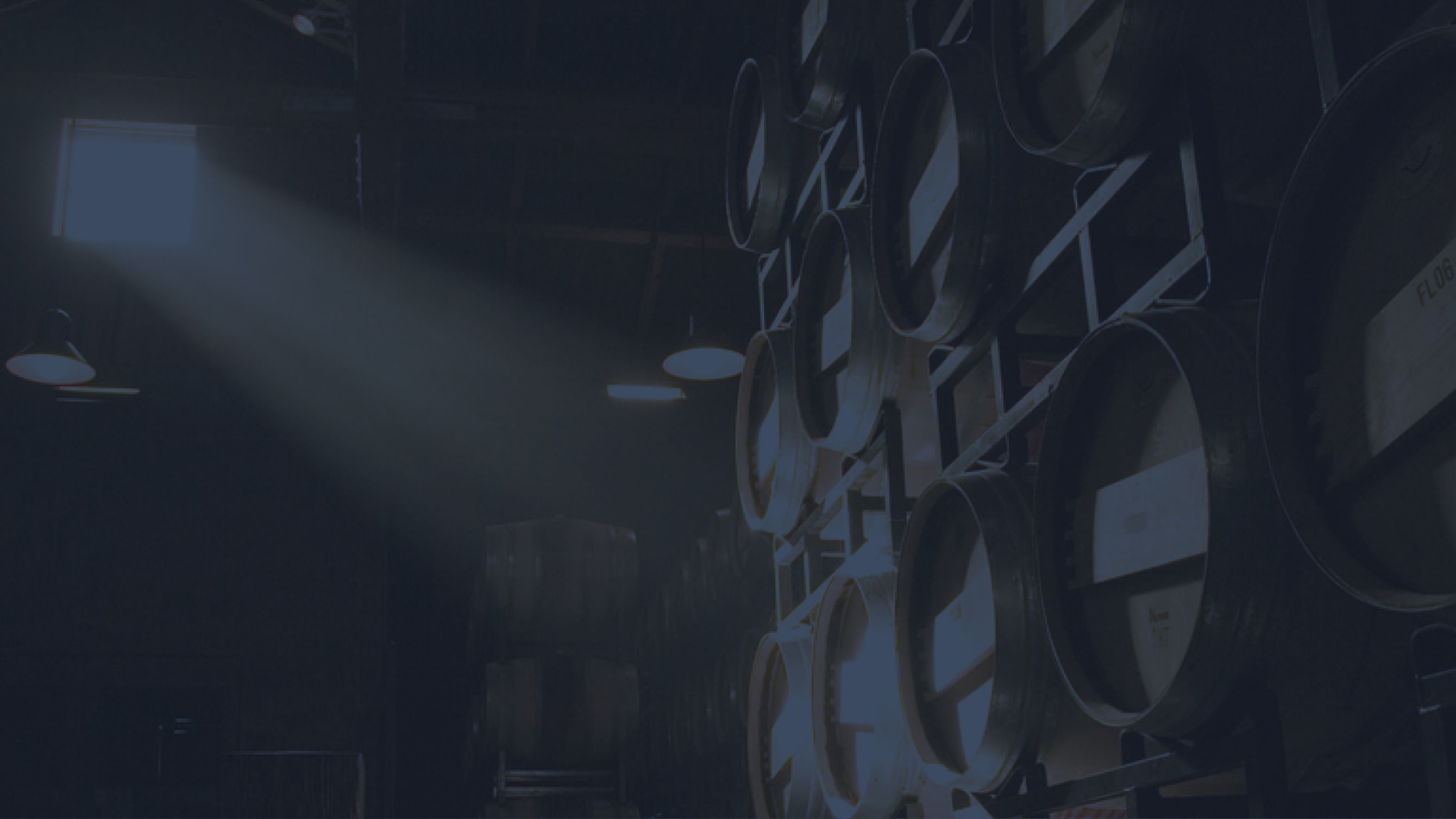
Advocating For Great Wine
The Napa Valley’s Golden Decade
A combination of driven winemakers, high-scoring wines and idyllic conditions firmly place the Napa Valley among the elite wine regions of the world.
A drive to continuously improve the quality of both the vines and the wine of the Napa Valley led to the “Golden Decade” of the 1990s.
Not only did the number of high-end producers increase exponentially, but the vintages themselves were some of the best on record. The years from 1990 leading up to 1997 were phenomenal, with the 1997 vintage still considered one of the best on record with nearly perfect weather.
This combination of driven winemakers, high-scoring wines and idyllic climates firmly placed the Napa Valley among the elite wine regions of the world.

1990s

Playing By Our Own Rules
Napa Green Establishes Sustainability Standards
Napa Green is established as a comprehensive sustainability certification, setting rigorous standards for both vineyards and wineries.
Napa Green’s focus is on protecting and restoring the Napa Valley watershed, conserving water and energy, and reducing waste and our carbon footprint, while also being conscientious employers and good neighbors.
For vineyards, Napa Green works to conserve precious water resources, prevent erosion and sediment runoff, identify and reduce harmful inputs, protect and restore riparian habitats, and ensure healthy employees and happy neighbors.
For wineries, Napa Green’s standards save energy and water, both by reducing usage as well as increasing efficiencies, reducing waste through recycling and composting, favoring environmental purchasing practices, and reducing greenhouse gas emissions and carbon footprints. As well, wineries care for employees, focus on being good neighbors, and take part in building excitement and engagement around sustainability.
Independent, third-party certification of vineyards and wineries ensures that Napa Green is one of the most rigorous sustainability accreditations available in today’s wine industry.

2000

Today’s Napa Valley
A World Renowned Wine Region
Reflecting on our past in order to seek inspiration for the future of the Napa Valley wine industry.
Today, we are nothing but enriched by our valley’s history of both triumph and adversity, pioneers and industry experts, busts and booms.
It’s been a long time in the making, but reflecting back on the story of how today’s Napa Valley came to be, we are inspired by an amazing spirit of cooperation, camaraderie and unity of purpose. It’s this very spirit that ensures our continued improvement in the vineyard, the cellar and of course, the bottle.

2026

California's First AVA
The Napa Valley Appellation
Our great diversity in soil types, microclimates and topography has led our vintners and growers to create defined grape-growing areas within Napa Valley, to help distinguish the effects of this diversity on the wine. These areas are called American Viticultural Areas, or AVAs.
The Napa Valley is itself an AVA, and it has been since it received its own designation in 1981. It is California’s first recognized AVA and the second in the United States.
Explore the Napa Valley AVA


An Exploration of Terroir
17 Nested AVAs
Atlas Peak
High in elevation, the Atlas Peak appellation is as rugged as it is stunning.
Climate: Cool, mountain influenced with temperatures about 10–15°F cooler than the valley floor in summer. Located above the fogline, there is a low day-to-night temperature range, with summer temperatures rarely rising above 90°F (32°C).
Elevation: 760 to 2,600 feet (232 to 792 m)
Rainfall: Up to 38 inches (96 cm) annually
Soils: Volcanic in origin, with basaltic red color, shallow with limited water retention. Irrigation is often essential.
Principal Varieties:
- Cabernet Sauvignon
- Chardonnay
Explore the Atlas Peak AVA
Calistoga
Located at the top of the valley and one of the most geologically uniform of all of Napa Valley’s AVAs.
Climate: Warm to hot, depending upon the time of year. Daytime summer temperatures may peak above 100°F (38°C) and fall to the low 40s°F(6°C) at night due to cool afternoon and evening breezes drawn in from the Chalk Hill Gap from the Pacific.
Elevation: 300 to 1200 feet (92 to 370 m)
Rainfall: Up to 60 inches (97 to 150 cm) annually
Soils: Almost completely of volcanic origin. Soils range from rocky, stony loam on the hillsides, to gravelly or cobbly loam on the alluvial fans, and heavier clay-silt soils in the valley center areas.
Principal Varieties:
- Cabernet Sauvignon
- Zinfandel
- Petite Sirah
- Syrah
Explore the Calistoga AVA
Chiles Valley
Find some of the Napa Valley’s oldest vines in this small AVA located high in the Vaca Mountains.
Climate: Fairly warmer summer days (mid-80s°F or 30°C), but due to higher elevation and summer fog, it can be quite chilly at night (below 50°F or 10°C). With a colder winter and spring, as well as strong winds, harvest comes later than on the valley floor.
Elevation: 600 to 1,200 feet (183 to 366 m)
Rainfall: Up to 35 inches (89 cm) annually
Soils: On the valley floor, primarily alluvial soils with silty-clay composition of marine origin, with good fertility. Hillsides show more clay-loam and stony-clay composition, mostly marine in origin, with some volcanic outcropping, and less fertility.
Principal Varieties:
- Cabernet Sauvignon
- Merlot
- Cabernet Franc
- Zinfandel
Explore the Chiles Valley AVA
Coombsville
Tucked into the foothills of the Vaca Mountains, find the Coombsville AVA just outside the city of Napa.
Climate: With weather moderated by its proximity to the San Pablo Bay, daily average high temperatures can be as much as 10°F cooler during hot months than most other AVAs, and heat spikes tend to be less severe.
Elevation: 100 to 1,000 feet (30-305 m)
Rainfall: Up to 25 inches (64 cm) annually
Soils: Primarily weathered volcanic rock and alluvial deposits from the Vaca Mountains that surround the region
Principal Varieties:
- Cabernet Sauvignon
- Chardonnay
- Merlot
- Syrah
- Pinot Noir
Explore the Coombsville AVA
Crystal Springs
Composed entirely of hillsides along the western face of the Vaca Range, find the Crystal Springs AVA just northeast of the city of St. Helena.
Climate: Hillside topography with slopes facing west-to-southwest, allowing for high solar radiation, which helps grapes mature each growing season. It's position below 1,400 feet means it gets shrouded in fog on many days, unlike the higher altitudes of Howell Mountain, which are above the fog line.
Elevation: 400 to 1,400 feet (121-426 m)
Rainfall: Averages 35 inches (89 cm) annually
Soils: Volcanic soils located on steep slopes, with grades of 15% to 40%
Principal Varieties:
- Cabernet Sauvignon
- Cabernet Franc
- Chardonnay
Explore the Crystal Springs AVA
Diamond Mountain District
Its name is inspired by the shards of reflective volcanic glass found in its ash-like soil.
Climate: Moderately warm temperatures with lower maximum temperatures (90°F or 32°C) and higher minimum temperatures (50°F or 10°C) than the valley floor, due to topography and altitude.
Elevation: 400 to 2,200 feet (122 to 671m)
Rainfall: Up to 55 inches (140 cm) annually
Soils: Residual uplifted soils of volcanic origin. Often reddish and very fine-grained, even gritty in texture, composed of both weathered sedimentary and volcanic origin soil.
Principal Varieties:
- Cabernet Sauvignon
- Cabernet Franc
Explore the Diamond Mountain District AVA
Howell Mountain
Explore the rolling hills and microclimates of this off-the-beaten path AVA.
Climate: Located above the fogline on the eastern side of the valley, this AVA is warmer and drier than other AVAs with more hours of sunshine and little-to-no marine influence.
Elevation: 1,400 to 2,600 feet (427 to 792 m)
Rainfall: Up to 50 inches (127 cm) annually
Soils: Predominantly volcanic and shallow. Drainage is high, fertility is low.
Principal Varieties:
- Cabernet Sauvignon
- Merlot
- Zinfandel
- Chardonnay
- Viognier
Explore the Howell Mountain AVA
Los Carneros
This region stays cool due to the marine fog and breeze coming in off the San Pablo Bay.
Climate: Cool, with prevailing marine winds from the San Pablo Bay and through the Petaluma Gap to the west. High temperatures during summer rarely exceed 80°F (27°C) with less diurnal range variation.
Elevation: Sea level to 700 feet (213 m)
Rainfall: Lowest in Napa Valley: up to 24 inches (61 cm) annually
Soils: Clay dominated, very shallow in general, with more loam and hillside alluvials in the northern areas. Yields typically are restrained by the hard claypan subsoil, which prevents deep-rooting.
Principal Varieties:
- Chardonnay
- Pinot Noir
- Merlot
Explore the Los Carneros AVA
Mount Veeder
The rugged mountain terrain of this AVA results in low yields and high ageability of its wines.
Climate: Cool to moderate, with most vineyards above the fogline, meaning warmer nights and cooler days but with less diurnal range than the valley floor. A typical mid-summer high temperature is about 85°F (29°C).
Elevation: 500 to 2,600 feet (152 to 792 m)
Rainfall: Up to 35 inches (89 cm) annually
Soils: Sedimentary based, former seabed, shallow and generally well drained, as well as more acidic, with low fertility. Most have a sandy or sandy-loam texture.
Principal Varieties:
- Cabernet Sauvignon
- Chardonnay
- Merlot
- Zinfandel
Explore the Mount Veeder AVA
Oak Knoll District of Napa Valley
Fog and breeze from the San Pablo Bay cause cooler summers and a long growing season.
Climate: Moderate to cool, marine air and fog can remain until late-morning. Late afternoon breezes frequently occur, maintaining slightly cooler temperatures than the upper valley. Mid-summer temperatures may reach 92°F (33°C) and drop to around 50°F (10°C) at night.
Elevation: Sea level to 800 feet (244 m)
Rainfall: Up to 36 inches (91 cm) annually
Soils: The valley's largest alluvial fan formed by Dry Creek creates the defining feature of the district. The northwest area is composed of volcanically derived soils, with stony or gravelly consistency. Southern and eastern areas transition from gravel to silty clay loam near the river.
Principal Varieties:
- Cabernet Sauvignon
- Chardonnay
- Merlot
- Sauvignon Blanc
- Riesling
Explore the Oak Knoll District AVA
Oakville
The Oakville AVA spans a well-drained expanse of gravel soil near the center of the Napa Valley.
Climate: Moderately warm, with temperatures commonly in the mid-90s°F (35°C) in the summer, but still strongly affected by evening and early morning fog, helping to maintain acidity. The eastern side of the AVA receives warmer afternoon sun.
Elevation: 130 to 1,000 feet (40 to 305 m)
Rainfall: Up to 35 inches (89 cm) annually
Soils: Primarily sedimentary, gravelly, alluvial loams on the western side, with more volcanic but heavier soils on the eastern side. Low-to-moderate fertility and fairly deep, with average water retention.
Principal Varieties:
- Cabernet Sauvignon
- Sauvignon Blanc
- Merlot
- Cabernet Franc
Explore the Oakville AVA
Rutherford
Located on the valley floor, the Rutherford AVA is warm with abundant sunshine.
Climate: Moderately warm, but still marginally influenced by early morning fog. The western bench area is cooler, with less late afternoon sun, tempered by afternoon marine winds. This AVA averages a bit warmer than Oakville and Stags Leap District to the south. Usual summer peak temperatures are mid-90s°F (35°C) with a large diurnal range.
Elevation: 155 to 500 feet (47 to 152 m)
Rainfall: Up to 38 inches (96 cm) annually
Soils: Western benchland is sedimentary, gravelly, sandy and alluvial, with good water retention and moderate fertility. The eastern side has more volcanic soils, and is moderately deep and more fertile.
Principal Varieties:
- Cabernet Sauvignon
- Sauvignon Blanc
- Merlot
- Cabernet Franc
Explore the Rutherford AVA
Spring Mountain District
On the steep eastern slopes of the Mayacamas Mountains is the Spring Mountain District AVA.
Climate: Cool to moderate depending on elevation and aspect. Most vineyards sit above the fogline,providing warmer nights and cooler days than the valley floor. Typical mid-summer high temperatures reach 85°F (29°C).
Elevation: 600 to 2,600 feet (183 to 792 m)
Rainfall: Up to 50 inches (127 cm) annually
Soils: Primarily sedimentary with weathered sandstone and shale. Loamy and friable in texture. Drainage is high, fertility is low.
Principal Varieties:
- Cabernet Sauvignon
- Merlot
- Cabernet Franc
- Chardonnay
- Zinfandel
Explore the Spring Mountain District AVA
St. Helena
Diverse soils and consistently warm weather are hallmarks of the St. Helena AVA on the narrow valley floor.
Climate: Warm, due to greater protection from western hills, with less fog or wind incursions. This narrowest part of the Napa Valley floor provides more heat reflection off the hillsides. Mid-summer temperatures often peak in the mid-to-high 90s°F (36°C).
Elevation: 400 to 800 feet (122 to 244 m)
Rainfall: Up to 40 inches (102 cm) annually
Soils: Southern and western borders are more sedimentary, with gravel and clay soils, lower fertility and moderate water retention. Further north and east, the soil is prevalently volcanic in origin, deeper and more fertile.
Principal Varieties:
- Cabernet Sauvignon
- Cabernet Franc
- Merlot
- Sauvignon Blanc
- Petite Sirah
- Zinfandel
- Viognier
Explore the St. Helena AVA
Stags Leap District
The first AVA in the U.S. to be created based on the distinct qualities of its soil.
Climate: Moderately warm with afternoon marine winds acting to cool the warmer air radiating off the bare rocks of Stags Leap itself and the surrounding hillsides. Mid-summer temperatures can reach 100°F (38°C), but more regularly are in the mid-90s°F (35°C).
Elevation: Sea level to 400 feet (122 m)
Rainfall: Up to 30 inches (76 cm) annually
Soils: Volcanic gravel loams are found on the floor of the valley, with rocky hillsides, and low-to-moderate fertility due to hard clay subsoils.
Principal Varieties:
- Cabernet Sauvignon
- Merlot
- Sauvignon Blanc
Explore the Stags Leap District AVA
Wild Horse Valley
The Wild Horse Valley AVA is the coolest of Napa Valley’s nested appellations.
Climate: Due to elevation and proximity to the San Pablo Bay, it is the coolest of all the Napa Valley AVAs. The air mass that passes over Carneros cools another 10 degrees by the time it rises to the Wild Horse Valley AVA.
Elevation: 850 to 2,130 feet (259 to 649 m)
Rainfall: Up to 35 inches (90 cm) annually
Soils: Volcanic in origin, with basaltic red color. Shallow with limited water retention, so irrigation is often essential.
Principal Varieties:
- Chardonnay
- Pinot Noir
Explore the Wild Horse Valley AVA
Yountville
Home to the Napa Valley’s very first vineyard, planted by George Calvert Yount in 1836.
Climate: Moderate, with cool marine influence and fog contributing to cool summer mornings. The strong breezes of San Pablo Bay keep afternoons more comfortable than further up valley. Mid-summer peak temperatures may reach the low 90s°F (33°C), with noticeable diurnal fluctuation to the mid-50°F range (13°C).
Elevation: 20 to 200 feet (6 to 61 m)
Rainfall: Up to 32 inches (81 cm) annually
Soils: Principally gravelly silt loams, sedimentary in origin, and gravelly alluvial soils with rock and moderate fertility.
Principal Varieties:
- Cabernet Sauvignon
- Merlot
Explore the Yountville AVA
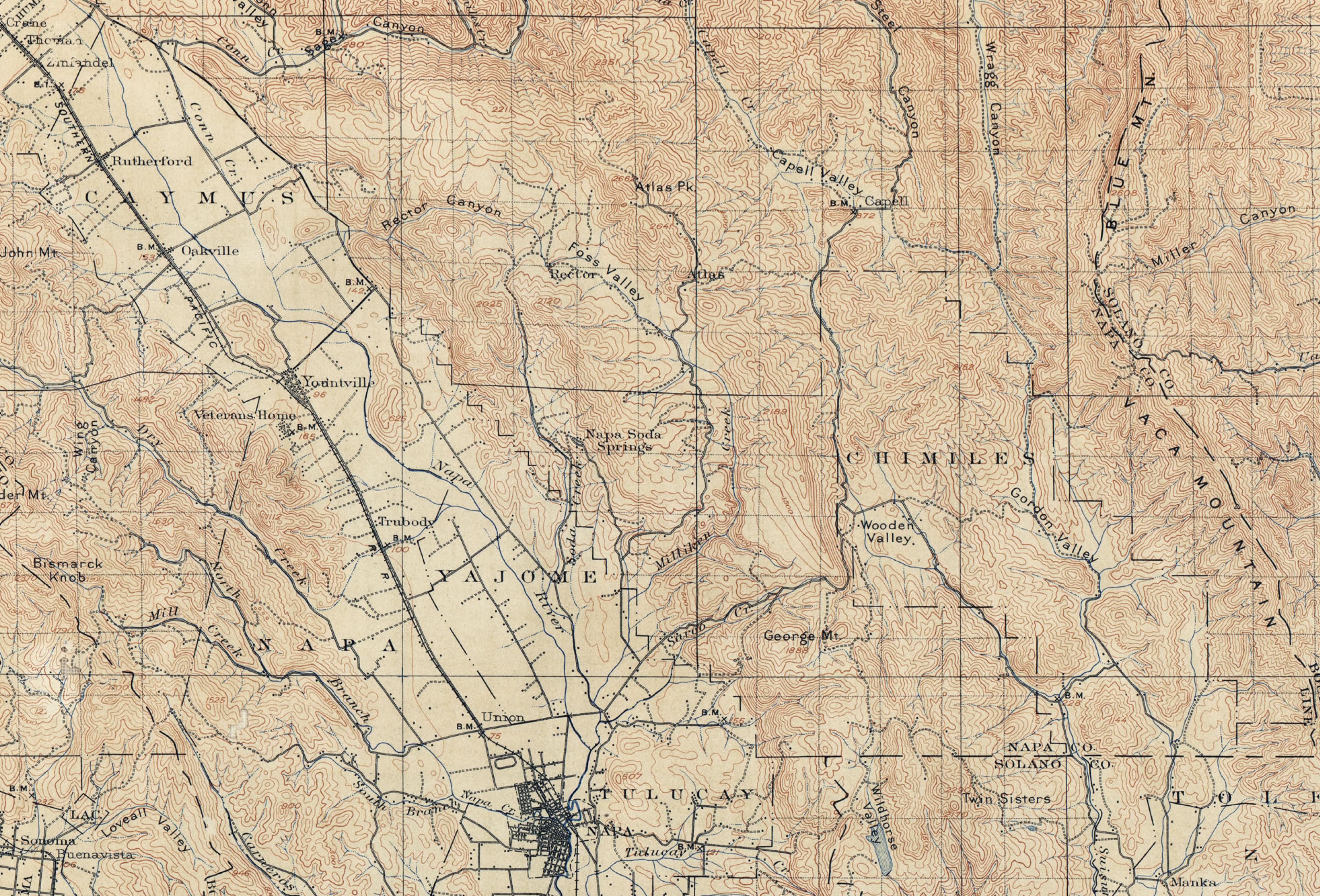
Where Taste Begins
What Is Terroir?
A combination of all natural elements in the environment in which a wine is grown, “terroir” speaks to climate, soil and topography. Some say it defines the heart of a region.
Learn About Napa Valley TerroirIdeal Growing Conditions
The Climate of Napa Valley
The Napa Valley is known for its large diurnal shifts—the temperature swing from daytime peak to nighttime low. This gives our fruit a chance to ripen slowly, maintaining the acidity needed for long ageability.
- An ideal dry Mediterranean climate
- Cooled by both coastal fog and wind
- Warmed by our two mountain ranges
- Dramatic & distinctive mesoclimates
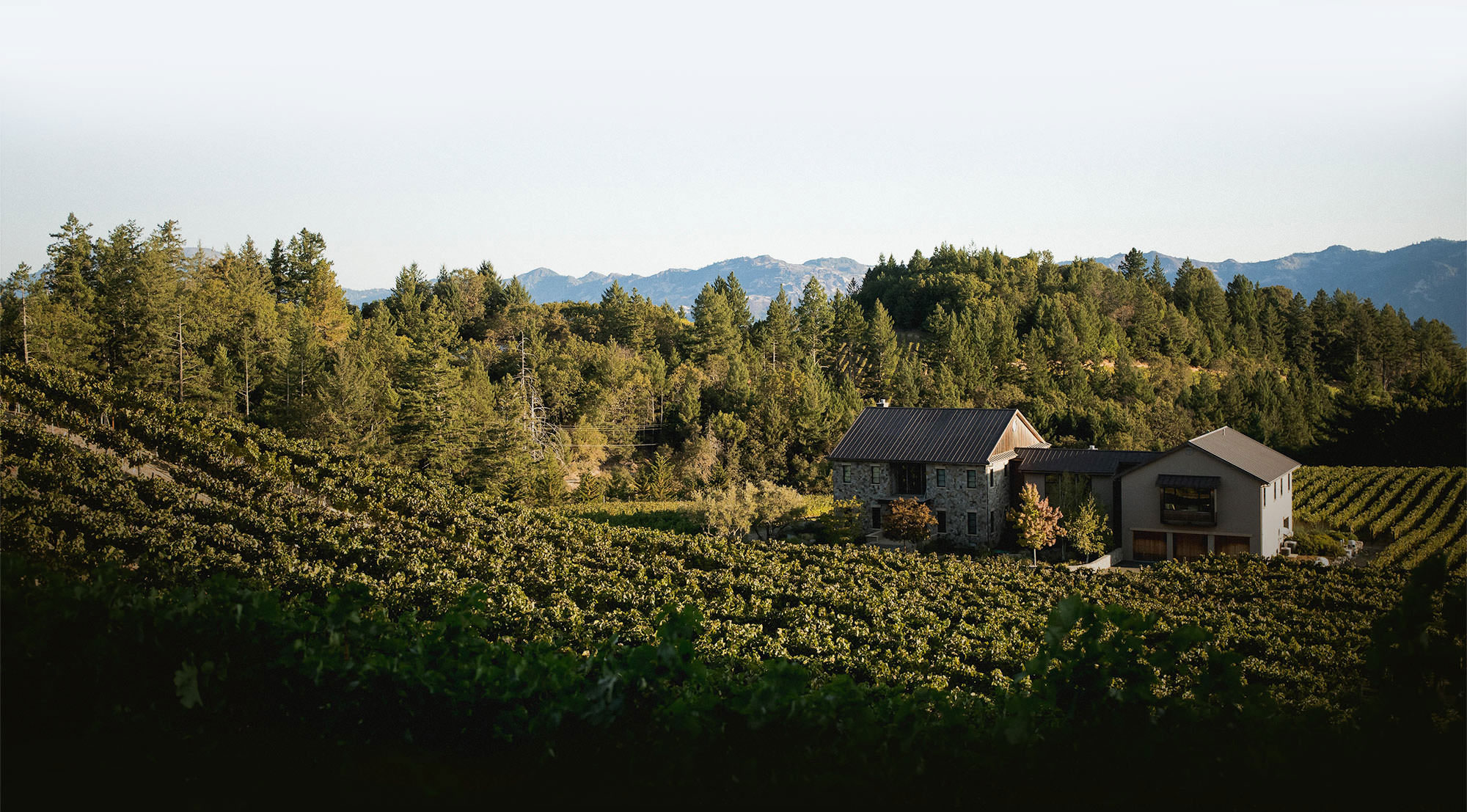
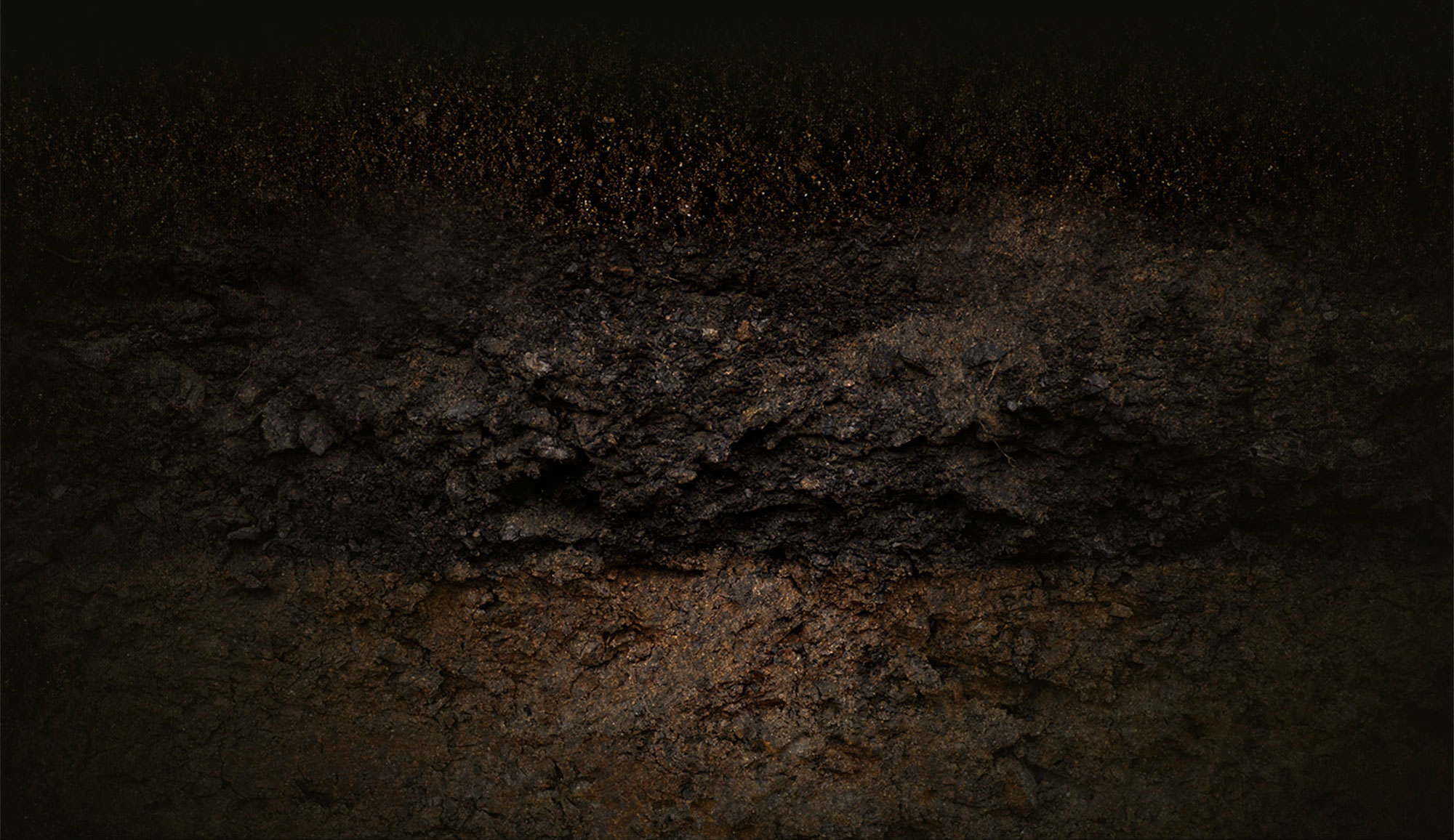
From the Ground Up
The Soils of Napa Valley
Dramatic geological events and the steady march of time have combined to form the agricultural eden that is the Napa Valley of today.
Deep Roots
Before a winemaker crafts an exquisite wine, before the sun ripens a grape cluster to perfection, a vine must first root itself into the earth. It must establish the foundation upon which it will draw nutrients to produce fruit.
And grape vines, like the humans who grow them, gain strength, viability and power through a bit of a struggle. Establishing deep, vigorous roots in search of water and nutrients, these same roots will impart a set of unique characteristics to the wine.
Soil Diversity
Walking every inch of the Napa Valley, the soil noticeably changes underfoot. Starting on the valley floor, the earth sinks into deep and rich alluvial soils of clay, gravel and sand carried in by centuries of running water. Upon the steep slopes of the valley walls, surrounded by rocky hillsides and volcanic soil, hearty vines spring from shallow soils. Venturing south, a calcium-rich soil mirrors the composition of silts found at the bottom of the San Pablo Bay, evidence of an earlier time when the bay waters extended farther inshore.
It’s on these incredibly varied soils, home to 50% of the world’s soil orders, that the Napa Valley is capable of producing such memorable wines of complexity and diversity.
Prehistoric Forces
150 million years ago, as Jurassic creatures roamed the Earth, the force of plate tectonics uprooted the Napa Valley from the ocean floor. This formed both the dramatic topography of our valley as well as unveiled a unique mix of volcanic and sedimentary soil types found in ancient seabeds.
Time, combined with a multitude of other geographical forces, exposed and eroded the earth into the wonderful mix of soil we have today.
This ancient soil supports a wide variety of vines with incredibly nuanced flavors, nurturing some of the most noteworthy wines in the world.
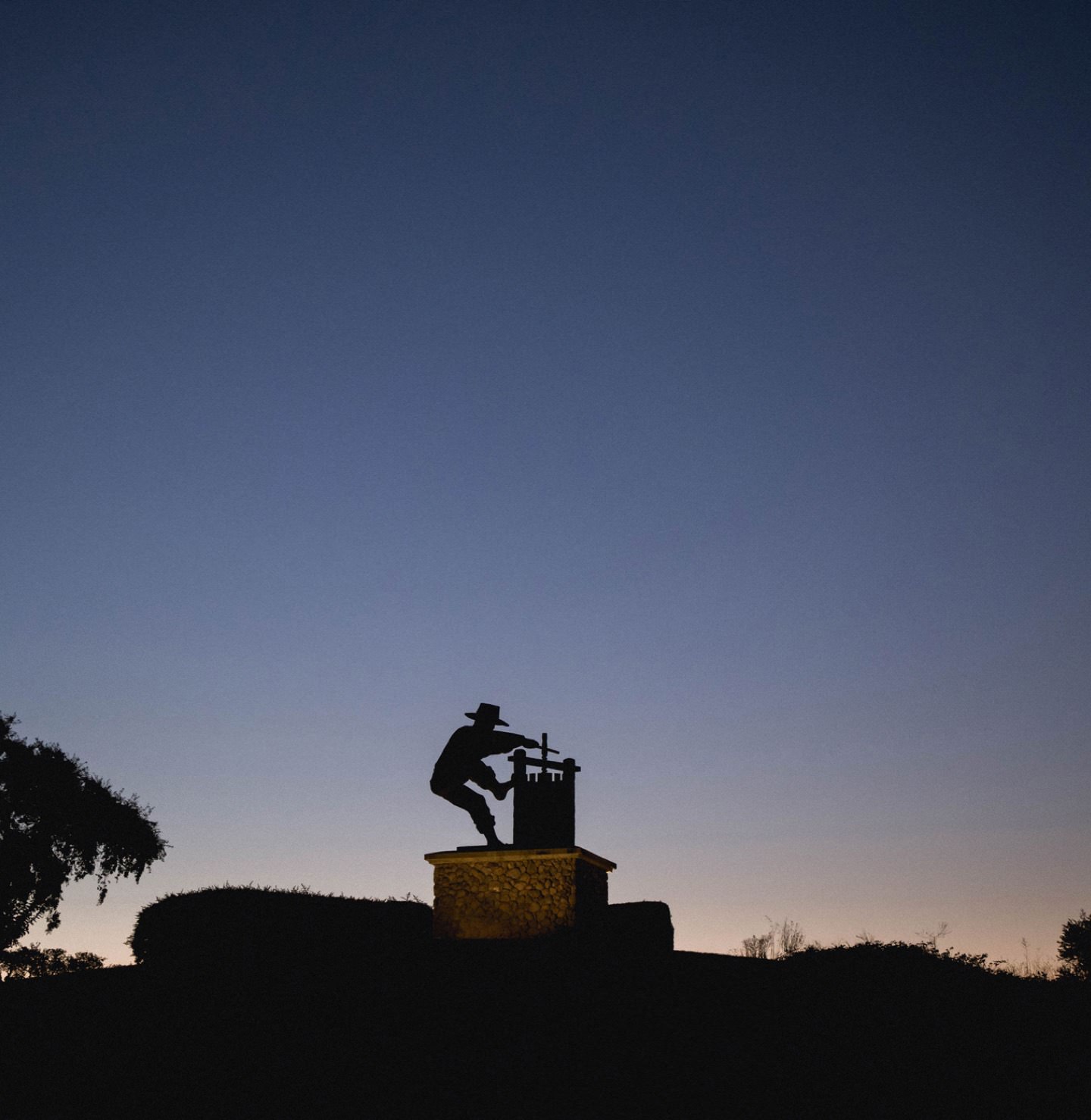

Environmental Leadership
Sustainability
The Napa Valley is a place steeped in history. As such, we’re taking action to preserve and protect the land for many generations to come. Our commitment to sustainability has resulted in nearly 450,000 acres of Napa County land under high levels of protection from development, widespread participation in the Napa Green program, and a culture of innovation that’s constantly supporting efforts to farm in the best interest of the land and community.
Agricultural Preserve
In 1968, the forward-thinking leaders of Napa Valley voted to enact our country’s first Agricultural Preserve, establishing agriculture as ”the highest and best use of the land” throughout the county.
This land-zoning ordinance, the first of its kind in the United States, is the foundation of our environmental efforts and has prevented the Napa Valley from becoming a high-density suburb of the San Francisco Bay Area. Without that foresight, Napa Valley likely would have followed in the footsteps of the Santa Clara Valley, which in 1968 was mostly fruit orchards and is now better known as the technology and business hub of Silicon Valley.
Today, the Napa Valley Agricultural Preserve remains intact and protects 32,000 acres through the continued support of residents.
Watershed Protection
Recognizing the threats of erosion that development could pose to Napa’s watersheds, in 1991, Napa County expanded environmental protections beyond just the valley floor. With the support of the vintner community, local officials enacted comprehensive and rigorous conservation ordinances that regulated hillside development and ensured that vineyards would have ample setbacks from streams.
The Greenbelt Alliance’s most recent report calculates that Napa County has more than 444,000 acres of land under protection with these measures.
Napa Green Certification
Established in the early 2000s, the Napa Green certification program elevates our commitment to sustainably producing world-class wine by protecting the land and conserving our valuable resources.
In the vineyard, Napa Green land practices protect soils, reduce harmful inputs and work to restore natural habitats. When it comes to winemaking, Napa Green members monitor energy, water and waste while conserving resources. And each certification ensures that employees are involved every step of the way, emphasizing social equity, engaging with neighbors and giving back to the community.
Slow & Steady Growth
In 1980, Napa County voters passed Slow Growth Initiative Measure A, which required that the Napa County General Plan adopt a Growth Management System that limits growth in Napa County to no more than 1% per year.
This measure, still in effect today, protects against sprawl and encroachment into agricultural land and open space. It also designates a set percentage of all new housing to be available to low-income families.
Setting Limits
By 1990, there were more than 200 wineries in the Napa Valley, and even with zoning and slow growth ordinances in place, there were no signs of slowing down. In keeping with the designation of agriculture as “the highest and best use of the land,” it soon became necessary to define how wineries should operate.
The Winery Definition Ordinance defines a winery as a place where wine is grown, produced and sold—and that’s essentially it. Art can be displayed, but not sold. Events can be hosted if its core function is to sell wine, but not if its core function is, for example, to bond two individuals in matrimony.
As the Napa Valley continues to gain world acclaim, our intention is that this reputation remains solely focused on the quality of the wine itself.
Climate Change
For as long as wine has been made in the Napa Valley, vintners have understood the importance of land stewardship. Today, we recognize the potential impacts of climate change and advocate for the adoption of local climate change policies, working with regional authorities throughout Napa County to determine how changes affect our region’s unique microclimates.
In 2019, the Napa Valley Vintners became the first North American wine trade association to join the Porto Protocol, vowing to continue emission-reducing efforts, promote beneficial practices with its membership, and share projects and resources with other wine regions around the world.


